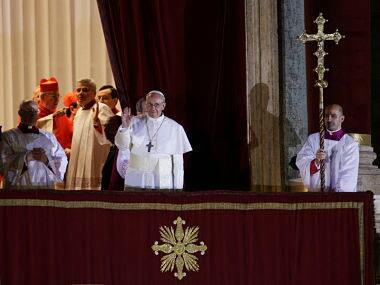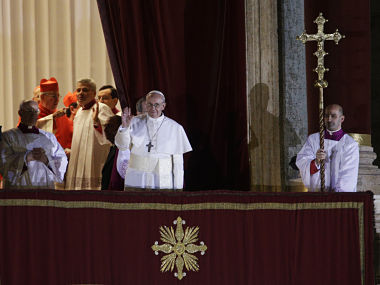Vatican City: Argentine Jorge Bergoglio has been elected pope, the first ever from the Americas and the first from outside Europe in more than a millennium. He chose the name Pope Francis. Cardinal Bergoglio, 76, has spent nearly his entire career at home in Argentina, overseeing churches and shoe-leather priests. The archbishop of Buenos Aires reportedly got the second-most votes after Joseph Ratzinger in the 2005 papal election, and he has long specialized in the kind of pastoral work that some say is an essential skill for the next pope. [caption id=“attachment_660216” align=“alignleft” width=“380”]
 Pope Francis flanked by Monsignor Guido Marini, master of liturgical ceremonies, waves to the crowd from the central balcony of St. Peter’s Basilica at the Vatican, Wednesday, March 13, 2013. Cardinal Jorge Bergoglio, who chose the name of Francis is the 266th pontiff of the Roman Catholic Church. AP Photo[/caption] In a lifetime of teaching and leading priests in Latin America, which has the largest share of the world’s Catholics, Bergoglio has shown a keen political sensibility as well as the kind of self-effacing humility that fellow cardinals value highly. Bergoglio is known for modernizing an Argentine church that had been among the most conservative in Latin America. Cardinals elected a new pope to lead the world’s 1.2 billion Catholics on Wednesday, overcoming deep divisions to select the 266th pontiff in a remarkably fast conclave. Tens of thousands of people who braved cold rain to watch the smokestack atop the Sistine Chapel jumped in joy when white smoke poured out a few minutes past 7 p.m., many shouting “Habemus Papam!” or “We have a pope!” - as the bells of St. Peter’s Basilica and churches across Rome pealed. Chants of `‘Long live the pope!" arose from the throngs of faithful, many with tears in their eyes. Crowds went wild as the Vatican and Italian military bands marched through the square and up the steps of the basilica, followed by Swiss Guards in silver helmets and full regalia. They played the introduction to the Vatican and Italian anthems and the crowd, which numbered at least 50,000, joined in, waving flags from countries around the world. “I can’t explain how happy I am right down,” said Ben Canete, a 32-year-old Filipino, jumping up and down in excitement. Elected on the fifth ballot, the pope was chosen in one of the fastest conclaves in years, remarkable given there was no clear front-runner going into the vote and that the church had been in turmoil following the upheaval unleashed by Pope Benedict XVI’s surprise resignation. A winner must receive 77 votes, or two-thirds of the 115, to be named pope. For comparison’s sake, Benedict was elected on the fourth ballot in 2005 - but he was the clear front-runner going into the vote. Pope John Paul II was elected on the eighth ballot in 1978 to become the first non-Italian pope in 455 years. Patrizia Rizzo ran down the main boulevard to the piazza with her two children as soon as she heard the news on the car radio. “I parked the car … and dashed to the square, she said. “It’s so exciting, as Romans we had to come.” The conclave played out against the backdrop of the first papal resignation in 600 years and revelations of mismanagement, petty bickering, infighting and corruption in the Holy See bureaucracy. Those revelations, exposed by the leaks of papal documents last year, had divided the College of Cardinals into camps seeking a radical reform of the Holy See’s governance and those defending the status quo. The names mentioned most often as “papabile” - a cardinal who has the stuff of a pope - included Cardinal Angelo Scola, the archbishop of Milan, an intellect in the vein of Benedict but with a more outgoing personality, and Cardinal Marc Ouellet, the Canadian head of the Vatican’s important bishops’ office who is also scholarly but reserved like Benedict.
Pope Francis flanked by Monsignor Guido Marini, master of liturgical ceremonies, waves to the crowd from the central balcony of St. Peter’s Basilica at the Vatican, Wednesday, March 13, 2013. Cardinal Jorge Bergoglio, who chose the name of Francis is the 266th pontiff of the Roman Catholic Church. AP Photo[/caption] In a lifetime of teaching and leading priests in Latin America, which has the largest share of the world’s Catholics, Bergoglio has shown a keen political sensibility as well as the kind of self-effacing humility that fellow cardinals value highly. Bergoglio is known for modernizing an Argentine church that had been among the most conservative in Latin America. Cardinals elected a new pope to lead the world’s 1.2 billion Catholics on Wednesday, overcoming deep divisions to select the 266th pontiff in a remarkably fast conclave. Tens of thousands of people who braved cold rain to watch the smokestack atop the Sistine Chapel jumped in joy when white smoke poured out a few minutes past 7 p.m., many shouting “Habemus Papam!” or “We have a pope!” - as the bells of St. Peter’s Basilica and churches across Rome pealed. Chants of `‘Long live the pope!" arose from the throngs of faithful, many with tears in their eyes. Crowds went wild as the Vatican and Italian military bands marched through the square and up the steps of the basilica, followed by Swiss Guards in silver helmets and full regalia. They played the introduction to the Vatican and Italian anthems and the crowd, which numbered at least 50,000, joined in, waving flags from countries around the world. “I can’t explain how happy I am right down,” said Ben Canete, a 32-year-old Filipino, jumping up and down in excitement. Elected on the fifth ballot, the pope was chosen in one of the fastest conclaves in years, remarkable given there was no clear front-runner going into the vote and that the church had been in turmoil following the upheaval unleashed by Pope Benedict XVI’s surprise resignation. A winner must receive 77 votes, or two-thirds of the 115, to be named pope. For comparison’s sake, Benedict was elected on the fourth ballot in 2005 - but he was the clear front-runner going into the vote. Pope John Paul II was elected on the eighth ballot in 1978 to become the first non-Italian pope in 455 years. Patrizia Rizzo ran down the main boulevard to the piazza with her two children as soon as she heard the news on the car radio. “I parked the car … and dashed to the square, she said. “It’s so exciting, as Romans we had to come.” The conclave played out against the backdrop of the first papal resignation in 600 years and revelations of mismanagement, petty bickering, infighting and corruption in the Holy See bureaucracy. Those revelations, exposed by the leaks of papal documents last year, had divided the College of Cardinals into camps seeking a radical reform of the Holy See’s governance and those defending the status quo. The names mentioned most often as “papabile” - a cardinal who has the stuff of a pope - included Cardinal Angelo Scola, the archbishop of Milan, an intellect in the vein of Benedict but with a more outgoing personality, and Cardinal Marc Ouellet, the Canadian head of the Vatican’s important bishops’ office who is also scholarly but reserved like Benedict.
Argentine Jorge Bergoglio is Pope Francis
FP Archives
• March 14, 2013, 01:24:10 IST
Argentine Jorge Bergoglio has been elected pope, the first ever from the Americas and the first from outside Europe in more than a millennium. He chose the name Pope Francis.
Advertisement
)